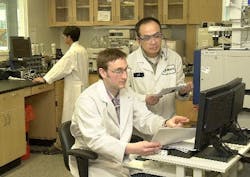After a long struggle, chemical manufacturers have recognized the economic value of green chemistry. Now, pharmaceutical manufacturers are following their lead, guided by the U.S. Environmental Protection Agency’s principles of green chemistry (see Principles of Green Chemistry below). In the process, they’re achieving significant efficiencies.
For example, consider process analytical technologies (PAT). While those who use PAT understand the efficiency benefits it offers, they may not realize that it also offers environmental benefits. “Process analytical technologies impact most, if not all, green chemistry principles,” says Julie B. Manley, senior industrial coordinator at the American Chemical Society’s Green Chemistry Institute (Washington, D.C.).
“PAT is about timely measurements with the goal of understanding and controlling pharmaceutical processes,” she says. “The better you understand your process, the better you can address green processing issues.” For example, using PAT for drying operations can reduce energy consumption by 80% while eliminating the lion’s share of off-spec product (itself considered chemical waste) and its attendant solvent and reagent waste.
At this point, most green pharma implementations are done after a drug has been approved. This parallels the way that traditional process analytics tests product after it has been produced, instead of during production. PAT not only offers manufacturers a way to “quality by design,” but a route for “green by design,” Manley says.
Solvent reduction: the sweet spot
Pfizer’s green chemistry program began with improvements to the process used to make its blockbuster antidepressant Zoloft (see Taking the Green Chemistry Challenge below), but the changes were substantial enough to require resubmission of the Zoloft CMC. “Pharmaceutical companies hate refiling,” says Buzz Cue, Ph.D., a consultant who helped Pfizer go green. The company recognized the economic advantages, however, and soon began investigating green processing for all its manufacturing. An effort that began at Groton, Conn., soon spread to Pfizer’s Michigan and San Diego facilities.
Solvent reduction is the sweet spot for greening any pharmaceutical process, says Cue. About 80% of pharmaceutical waste results from solvent use, with the remainder related to reagents and raw materials. Solvent recycling is a step in the right direction, but recovery is costly and inefficient. When redistillation is the only option, PAT can help optimize that operation.
Adopting nontoxic solvents is not always possible, but works far more often than one might think. Relatively benign solvents derived from renewable sources, such as ethyl acetate and 2-methyl THF, are now making inroads into pharmaceutical processing, “and they’re every bit as good as methylene chloride,” Cue says.
Cue also likes what he calls “embryonic” processing such as flow or continuous reactors to cut down on reaction time and energy and solvent usage. “Pharmaceuticals are very much still a batch industry, with everything done in the equivalent of giant round-bottom flasks,” he notes. “Continuous processing eases scaleup, leading to lower solvent usage and robust, rugged processes, which FDA likes very much.”
The power of enzymes
Enzymes are the ultimate green processing agents: catalytic, specific and environmentally benign. The food, cleaning products and personal care industries use hundreds of tons of dirt-cheap enzymes, both as ingredients and as process reagents. High-fructose corn syrup, the world’s largest-volume sweetener, is produced using an amylase (sugar-processing) enzyme that costs pennies per gram.
For a host of reasons, pharmaceutical processors have been reluctant to adopt enzyme-based processes. Organic chemists, for example, avoid water-based reactions like vampires shun mirrors. More importantly, aqueous operations steps are starkly discontinuous within an otherwise traditional chemical-pharmaceutical process. To make an enzyme step work, chemists must isolate the intermediate at some reasonable level of purity from the organic reaction pot, transfer it to aqueous media, reisolate it and send it back upstairs to the organic reactor.
Lipases are the most popular enzymes in pharmaceutical manufacturing, used mostly for resolving racemic acids by condensation with alcohol to form esters, or through the reverse reaction. Processors are not thrilled about enzymatic resolutions where half the product is discarded. Still, with most drugs investigated, if not developed, in enantiomerically pure form, lipase resolutions are here to stay. An even greener approach — especially for companies already considering a lipase step — is to introduce chirality through enzymes at a different point in the synthesis.
Enzymes are top performers for introducing chirality through reductions of prochiral ketones, aldehydes, imines and other unsaturated functional groups. Interested manufacturers can tap into expertise at enzyme specialty companies such as Novozymes (Franklinton, N.C.) and Dyadic (Jupiter, Fla.). Neither company has much pharmaceutical industry experience, but both are nevertheless interested in demonstrating how enzymes can “green” chemical-pharmaceutical manufacturing.
Novozymes, part of the Novo Group (as in Novo Nordisk), is the world’s largest producer of industrial enzymes. Staff scientist Sevens Pearce, Ph.D., eagerly describes the “huge potential” of enzymes in oxidations, reductions, resolutions and a host of other organic transformations but recognizes the hurdles as well. “There is no organic compound produced by living organisms that was not made by enzymes,” he says. “We simply need to get people in the pharmaceutical industry to look at enzymes in that light.”
Making hay
Today’s enzymes are not the fragile proteins of yesteryear. Modern industrial enzymes survive high salt concentrations and extremes of temperature, and when the reaction is complete there is no organic waste to deal with. Novozyme’s production facility is the second-largest enzyme manufacturing site in the world and is considered a zero-discharge facility because all its waste is recycled in local agriculture. “We’ve fertilized quite a bit of hay down here,” Pearce notes.
A green approach related to enzymes is the generation of intermediates, usually chiral compounds, from fermentation sources instead of petroleum feedstock. This idea is anything but pie-in-the-sky. Microbia (Cambridge, Mass.), a discovery and development pharmaceutical company with two drugs in early-stage clinical testing, uses molecular biology and genetics to optimize production of commercially-valuable intermediates for food, pharmaceutical and chemical companies. In February of this year, the company entered into an agreement with DuPont to generate, through microbial fermentation, a chemical which was previously sourced from the petrochemical industry.
In November 2005, Microbia extended its earlier deal with Ranbaxy, India’s largest pharmaceutical company, for an undisclosed pharmaceutical intermediate. The two firms had previously collaborated on a project involving a Ranbaxy statin product. Earlier in 2005, Microbia began a research collaboration with Singapore’s Bioprocessing Technology Institute to produce cytotoxic metabolites in bacteria as possible cancer therapeutics.
Sourcing microbe-derived intermediates makes the most sense when applied early in drug development. But in the real world, companies are eager to get products out the door by whatever means. According to Rich Bailey, Ph.D., VP and general manager at Microbia, drug manufacturers can also derive benefits from “after-market” process optimization. “Fermentation’s cost-effectiveness is easily justified after the fact, as experience in numerous industries has indicated,” he says. Notable switches from chemical to biochemical production include vitamin B2, and carotenoid colorants, ingredients and food supplements, a $1 billion-plus worldwide industry.
Issues persist
Green chemistry is a trend to keep an eye on, although by some accounts the industry is not doing enough. Jody Roberts, Ph.D., Charles C. Price Fellow at the Chemical Heritage Foundation (Philadelphia) believes interactions between the chemical industry and environmentalists are still a bit too rocky for comfort.
Roberts, who holds an undergraduate chemistry degree, cites “missed opportunities” to develop benign processes in the first place (as opposed to fixing past mistakes). “I don’t want to sound like a curmudgeon, but today’s green chemistry initiatives fail to acknowledge the depth of the pollution problem.”
While crediting pharmaceutical industry efforts to clean up manufacturing, Roberts notes that drug makers are still reluctant to “green” a process in the absence of clear economic incentives. The solution, he believes, is to teach green principles at the earliest stages of chemistry education, and perhaps to send chemistry professors “back to school” to learn these ideas themselves.
Of course, drugs that provide novel or best-in-class benefits will be approved, regardless of their green status. “But if you can incorporate green processing early on, into the design and eventually production, there is no reason why all pharmaceutical manufacturing can’t be green,” says Buzz Cue. “At some point, ‘green-ness’ ceases to be an issue and everyone simply is doing chemistry again.”







